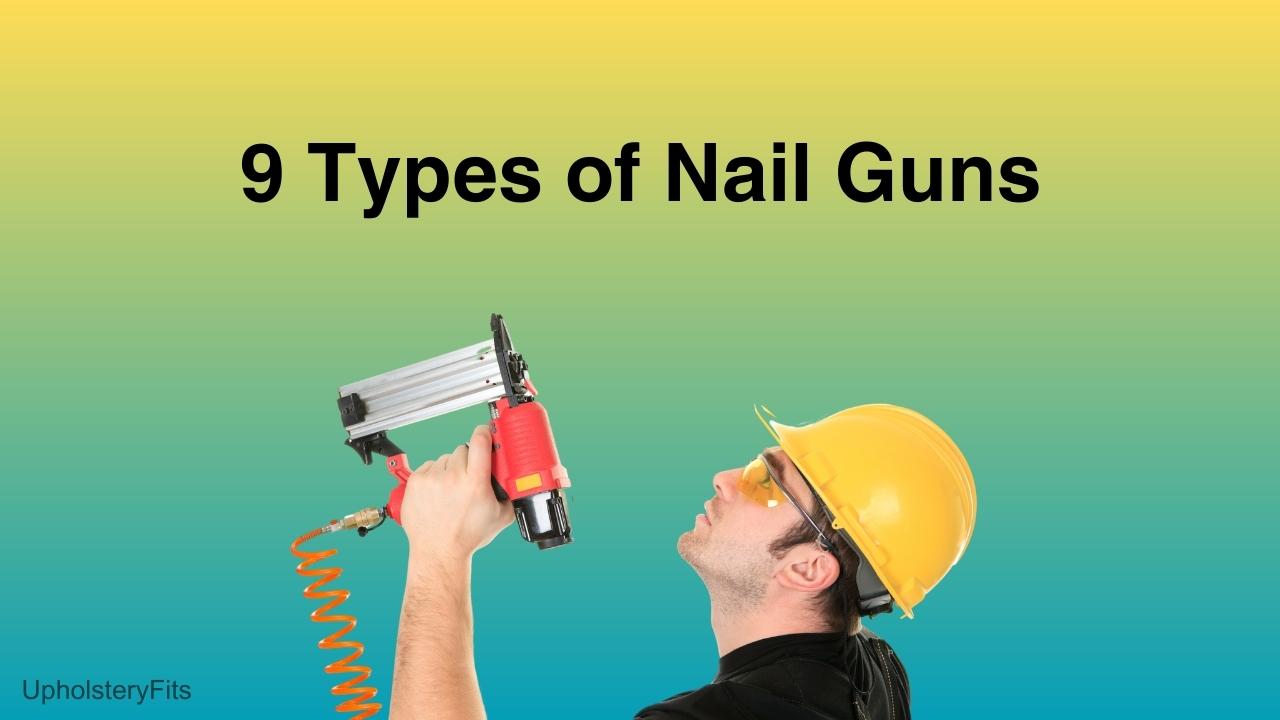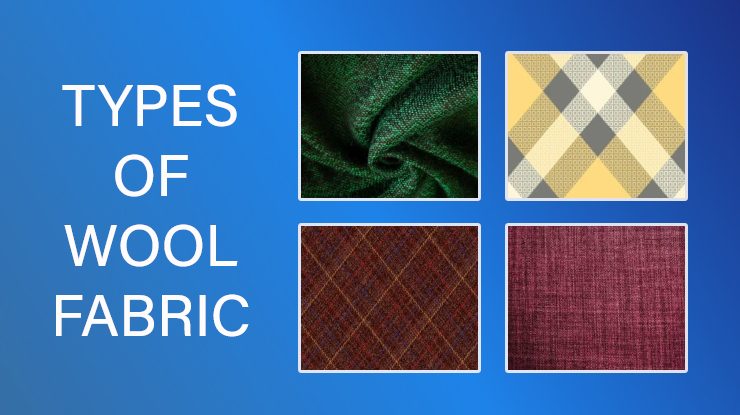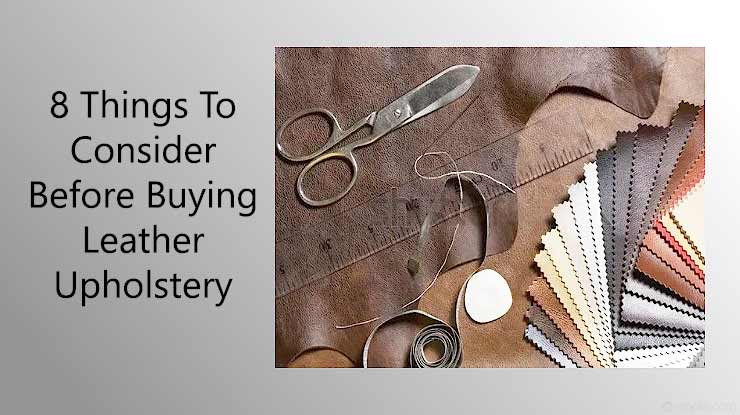Before I explain in depth why you need to read this article. Ask yourself these questions.
Tired and fed up with the stress caused by a hammer for nailing?
Looking for an easy informative in-depth report on which type of nailer suits you?
Are you a professional or DIY lover who spends time in his/her workshop using a nail gun?
With the help of various types of nailers, you can easily get the work done. But the question is which type of nailer is the best for you?
I’ll explain it clearly.
Nail Guns have different types of models available for you in the market according to your price range and according to the tasks you’re dealing with.
I’ll tell you which nailer is the best one for you on the basis of my extensive search.
In this article, I’ve included a comparison chart of various types of nailers that’ll help you choose the right nailer for you according to your job and is suitable for various household tasks.
After completely reading this article, you’ll have all the information you need to choose the right kind of nailer for your personal and professional use.
So, let’s begin.
| Best Overall | Metabo HPT Roofing Nailer |
| Best for Bucks | NuMax SFR2190 Framing Nailer |
| Best for Quality | Freeman PE4118GF |
Overall Comparison Chart
I’ve explained a brief side-by-side comparison of the most popular types of nailers if you’re in a hurry. You can see it right below:
| Nailer Type | Pros | Cons |
| Roofing | Quick loading mechanism, efficient working, compact design, high quality, depth adjustment, high strength, powerful working | Limited versatility, expensive to maintain and buy, not affordable for daily use, less maneuverability, large size and weight, less portability, difficult to carry and handle |
| Flooring | These nailers have high cost and maintenance issues, are larger in size and more weight, are suitable only for flooring, not flexible. | Suitable for heavy-duty nailing, can be used for a variety of floorings, easy to use and is convenient, easy load and fire mechanism |
| Framing | Not effective precision, not suitable for carrying from place to place, limitations in types of nails which can be used, is not cost-friendly and affordable for different users, not that much accuracy | Difficult to handle and maintain, have less precision than finish or brad nailers, only uses specific sizes of nails, are expensive in price, have large size and more weight |
| Siding | Strong holding power, provides depth adjustment according to different types of materials, quick loading and firing mechanism, versatile and flexible in nature, provides high speed | Reduced damage while operating, high performance, in-depth adjustment, efficient and powerful action, precision, and versatility |
| Finish | Fragile, produce safety issues, is quite expensive, has limited depth range, has limited strength, has limited applications | Preferable for heavy-duty jobs, easy to conceal, provides a quick nail-driven mechanism, strong holding power, specialized features for finishing trim or wood, etc. |
| Brad | Easy usage, high functionalities, minimal damage while usage, versatile nature, really good precision, high-speed working | High maintenance cost for it, expensive as compared to other nailers, have a limited depth unlike others, have low strength, ranged applications |
| Pin Nail | Expensive to maintain, limited working range, limited strength, noise while it’s working, difficult for some users | Fragile, produces safety issues, is quite expensive, has limited depth range, has limited strength, has limited applications |
| Unique Nail Guns | Precision, versatility, ease of use, portability, power, reduced risk of splitting of nails, use small-sized nails | A lot of jamming issues, difficulty to use with hard materials, can cause injury as well if not properly used, the finishing might not be good |
| Staple Gun | Versatility, speed, high strength and power, precision, lightweight, portable, easy to handle, easy to maneuver | expensive because of the large size of nails, limited maneuverability due to its large size, a heavyweight in comparison to others, no depth adjustment feature, and large nail size causes problems. |
Roofing Nailers
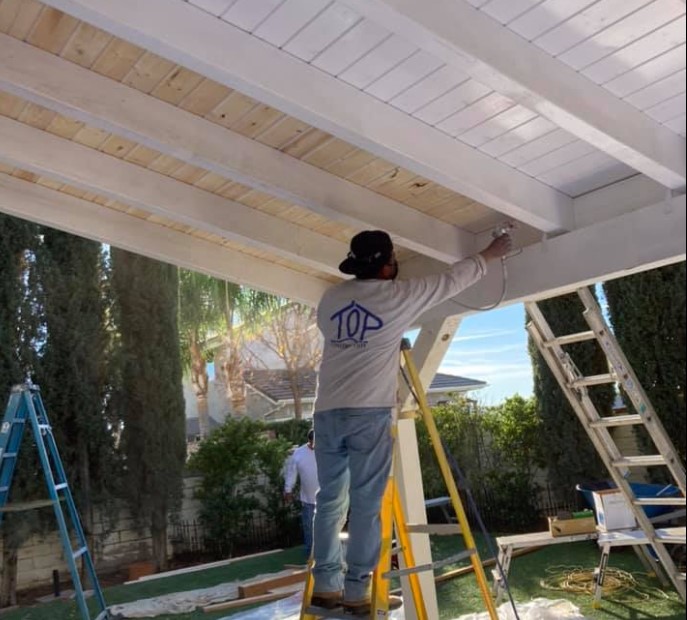
Roofing Nailers make the process of installing materials on your roof convenient. These types of nailers can easily be used by professionals, and for DIY-er who want to install their roofs.
One of the top-rated roofing nailers in the market is Hitachi (Metabo) NV45AB2.
Comparing Roofing Nailers
Here is a small interim table to scale the best product in this particular niche, if you are no expert and want to scroll down, let me help you. See the table. Note that the Grade sequence is from Poor, Average, Good, Better, and Excellent.
| Roofing Nailer Type | Best Category Product | Grade |
| Pneumatic Roofing Nailer | Metabo HPT Roofing | Excellent |
| Cordless Roofing Nailer | Dewalt DCN45RND1 Cordless | Average |
Types of Roofing Nailers:
Explain the main purpose of the pneumatic roofing nail gun for experts. Give precise information for my website blog. Answer the following questions in sequence.
Exactly what type of roofing surfaces is a pneumatic nail gun used for installing a roof?
Is it better than a cordless roofing nailer?
Which materials are used to install a roof using a pneumatic nail gun? Give a list.
Pneumatic Roofing Nailer
A pneumatic roofing nail gun is typically used for installing asphalt shingles, but it can also be used on other roofing surfaces such as cedar shingles, felt paper, and some metal roofing materials. It’s important to choose the right type of nail gun and nail length for the specific roofing material you’re using to ensure a secure installation.
The best in the category is the Metabo.
Cordless is not powerful or has the same capacity as a pneumatic nail gun.
Hitachi Nailer can be easily used with a variety of surfaces like metals, woods of different types, and similar materials.
When it comes to power and strength, it has a 120 pcs side loading magazine and it provides an ideal high pressure of about 70-120 PSI which is really remarkable and it helps in quick driving nails with high pressure into a variety of materials.
Cordless Roofing Nailer
Now, let’s discuss cordless roofing nailers. they work the same as pneumatic roofing nailers but the only difference is the power and performance.
In this category worth mentioning best is the Dewalt Roofing Nailer.
Cordless Roofing Nailers have a large storage capacity since they are portable. These nailers can also be used with a variety of surfaces and you can adjust them according to the material being dealt. They provide a comfortable grip to the users to get a good hold of it when dealing with different materials.
And the most flexible component is their versatility and maneuverability. Cordless roofing nailers are battery-powered so it makes them really multipurpose.
The Pros
- Roofing Nailers are ideal for installing components on the roof.
- They are strong and durable due to the types of nails they use.
- The depth adjustment feature also makes them adaptable to different kinds of depths.
The Cons
- They are heavy and difficult to carry from place to place.
- Only useful for the installation of roofing materials, which limits their range as well as their versatility.
- They produce some noises as well during their work which is quite distracting. These nailers are also expensive and really difficult to maintain.
Flooring Nailers
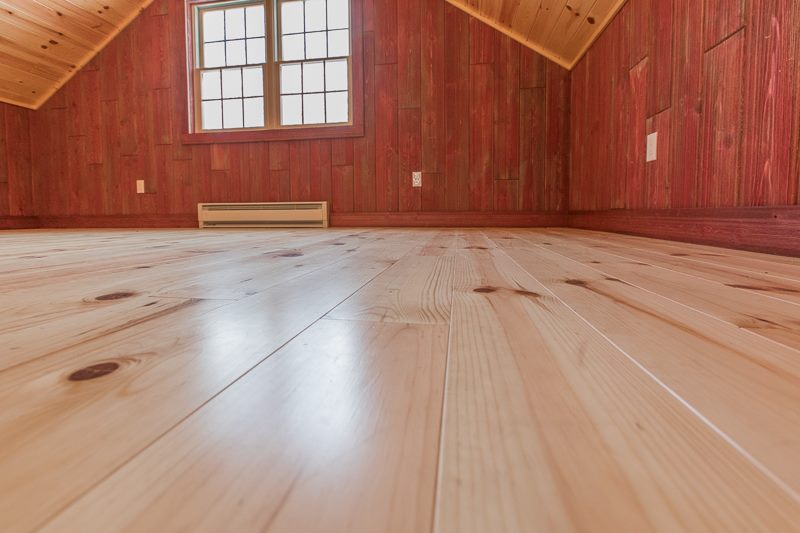
Now, comes the flooring nailers. They are used on different types of floors. The appropriate type of flooring nailer can be used Hardwood flooring (most commonly used), Engineered flooring (thin layer of hardwood on top of a plywood base), and Bamboo flooring (most popular nowadays). materials like vinyl tiles can be installed on the floor.
Among flooring nailers, the most remarkable flooring nailer these days is NuMax SFL618.
Comparing Flooring Nailers
| Flooring Nailer Type | Best Category Product | Grade |
| Pneumatic | NuMax SFL618 | Good |
| Cordless | Freeman PE4118GF | Better |
| Manual | Valu-Air 9800RC | Average |
Here are some types of flooring nailers:
Pneumatic Flooring Nailer
The performance and strength of pneumatic flooring nailers are always more than electric and manual nailers. Pneumatic nailers can be used with materials like groove hardwood for the installation of different types of materials. NuMax is quite a name in this category.
In terms of materials:
- Cleat nails: these are typically used for solid hardwood flooring.
- Staples: these are often used for engineered wood and bamboo flooring.
- L-shaped nails: these are used for thinner materials, such as plywood or particleboard.
Cordless Flooring Nailer
The cordless flooring nailers can easily be carried to different places without any kind of restrictions. As a battery-powered nailer can be only used for some time unless it’s charged, unlike pneumatic flooring nailers.
Freeman PE4118G is worth mentioning in the cordless flooring nailer category and it’s remarkable for the variety of jobs related to driving nails for the installation of different flooring materials.
These nailers are applicable to floor surfaces of wood for installing materials like paneling, insulation, upholstery, plastic sheeting, etc.
Manual Flooring Nailer
These types of nailers are preferred when a user prefers a comparatively cheaper flooring nailer than pneumatic or cordless.
In this category, Bostitch Flooring Nailer is worth mentioning due to its efficiency.
Manual flooring nailers are quite easy to. Manual nailers can be used at any place and at any time without requiring any power source.
The multiple applications of manual flooring nailers include hardwood flooring, installing insulation materials and other components on your floor, or for installation of carpets.
The Pros
- These nailers are suitable for multiple types of work surfaces.
- You can potentially save on costs.
- If you’re doing the work yourself, you can save time and potentially reduce the risk of making mistakes that could require costly repairs.
The Cons
- These nailers have less versatility due to their large-sized nails and they can be only used with specific projects.
- Since technology evolved these nailers are not really used.
Framing Nailers
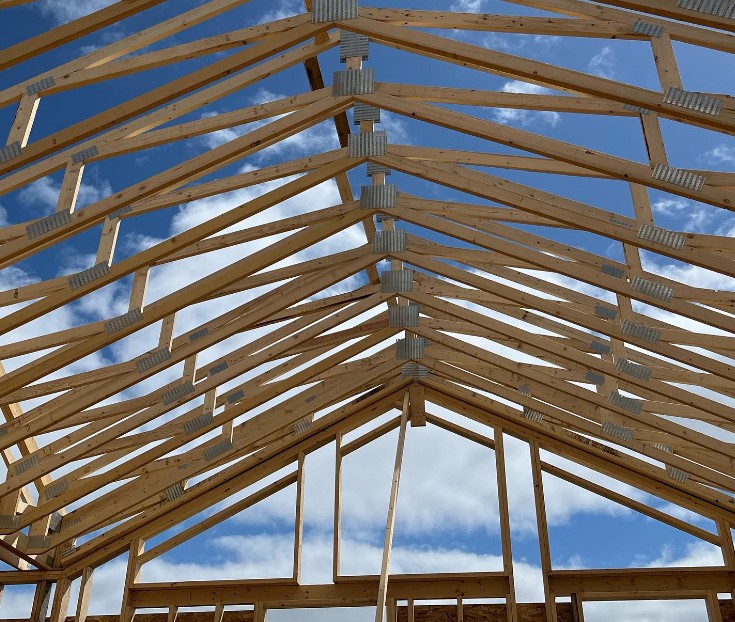
A framing nail gun is a tool that is designed to drive large nails into wood framing members, such as studs, joists, and beams. These nails are used to secure the framing materials together, forming the structural skeleton of a building.
Worth mentioning in this category is the NuMax SFR2190 Pneumatic.
Comparing Framing Nailers
| Framing Nailer Type | Best Category Product | Grade |
| Pneumatic | NuMax SFR2190 | Better |
| Gas nail | Metabo HPT NR83A5 | Good |
| Cordless | Metabo HPT NR1890DCS | Good |
Framing Nailers have the following categories:
Pneumatic Framing Nailers
These nailers have several features like depth adjustment, interchangeable mode, etc. according to the materials that are being dealt with.
Bostitch Pneumatic Framing Nailer is quite in demand in the market for a variety of reasons.
They are widely applicable to a variety of surfaces like wooden surfaces for framing purposes. These nailers include large nails which are quite suitable for framing different materials.
Gas Framing Nailers
Gas framing nailers are powerful tools as compared to pneumatic nailers because their entire work depends on the combination of a fuel cell and a battery power source for driving nails into a variety of materials. These types of nailers are more powerful as compared to pneumatic framing nailers because they don’t require a power source for their work.
Paslode – Cordless Nailer is considered to be among the most remarkable gas framing nailers.
The gas framing nailers are portable and cordless just like cordless framing nailers.
These gas framing nailers can be expensive to maintain and use because the fuel cell must be changed after some time which involves some expenses. The pneumatic framing nailers are comparatively cheaper.
Cordless Framing Nailers
Cordless Framing Nailers also work similarly to the above two types, but the major difference is that being cordless and mobile.
Dewalt Framing Nailer is worth mentioning in the category of cordless framing nailers because of its high demand in the market and its power and efficiency.
They can be easily used at places that are tight and really hard to access.
They often use nails of size 3-1/2 inches and are most suitable for applications like framing and sheathing etc. These nailers are also comparatively more expensive.
The Pros
- Framing nailers provides quick speed and release mechanism while use.
- Produces really less noise.
- They provide depth adjustment as well due to which the depth of the framing nails can be adjusted accordingly.
- They provide strong holding power as well because the framing nails are thick and long which helps keep stuff together.
The Cons
- Framing nailers are less portable and really difficult to carry from one place to another.
- They have really low precision as they make large holes in the surface as the framing nails penetrate the surface.
- These nailers are expensive as well and due to their large nail size, their range of applications is limited as well which is a really big drawback.
Siding Nailers
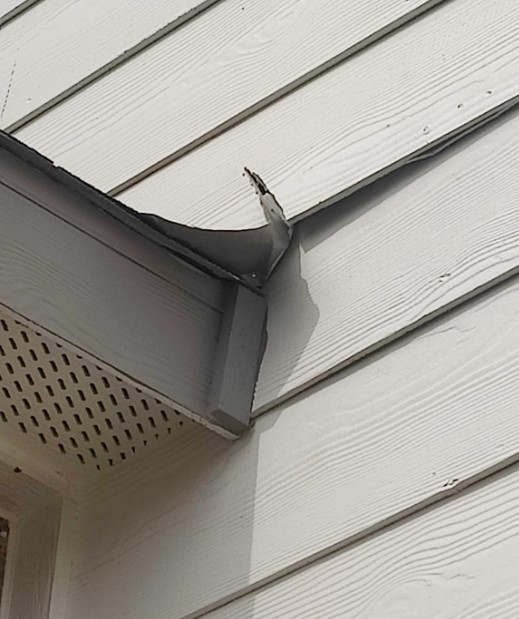
Siding nailers are the nailers which are used for the installation of siding materials to the exterior of buildings. The siding materials include fiber and other multiple types of wood.
Worth mentioning is the Bostitch Nailer N66C which is considered the right choice overall for a siding nailer in the current times.
Comparing Siding Nailers
| Framing Nailer Type | Best Category Product | Grade |
| Electric | DeWalt DCN45RNB | Good |
| Pneumatic | BOSTITCH Coil Siding Nailer | Better |
Siding Nailers also have sub-categories:
Electric Siding Nailer
The electric siding nailer mechanism is completely opposite to that of the pneumatic siding nailer.
Electric siding nailers use multiple types of nails and they include strip nails or different types of coils which are made to support the siding materials.
The depth of the siding nailers can easily be adjusted according to the materials being dealt with.
Worth mentioning in this category is the Dewalt.
Pneumatic Siding Nailer
A Pneumatic Siding Nailer gun is used to attach various types of siding materials to the exterior of a building, such as wood, fiber cement, vinyl, and metal. It can be used on both new construction projects and renovation projects.
They also use coils and strip nails which are applicable and useable with a variety of siding materials.
The Bostitch Coil Siding Nailer is the top-rated pneumatic sliding nailer.
The Pros
- The depth can easily be adjusted according to the types of materials being dealt and the siding nails that are used can be driven to a variety of depths easily.
- They have a quick-loading magazine.
- These nailers also provide strong holding power as the siding nails are thick.
The Cons
- Siding nailers provide less accuracy and precision and they can cause damage to the surface by leaving behind large holes.
- These nailers are quite difficult to maneuver.
Finish Nailers
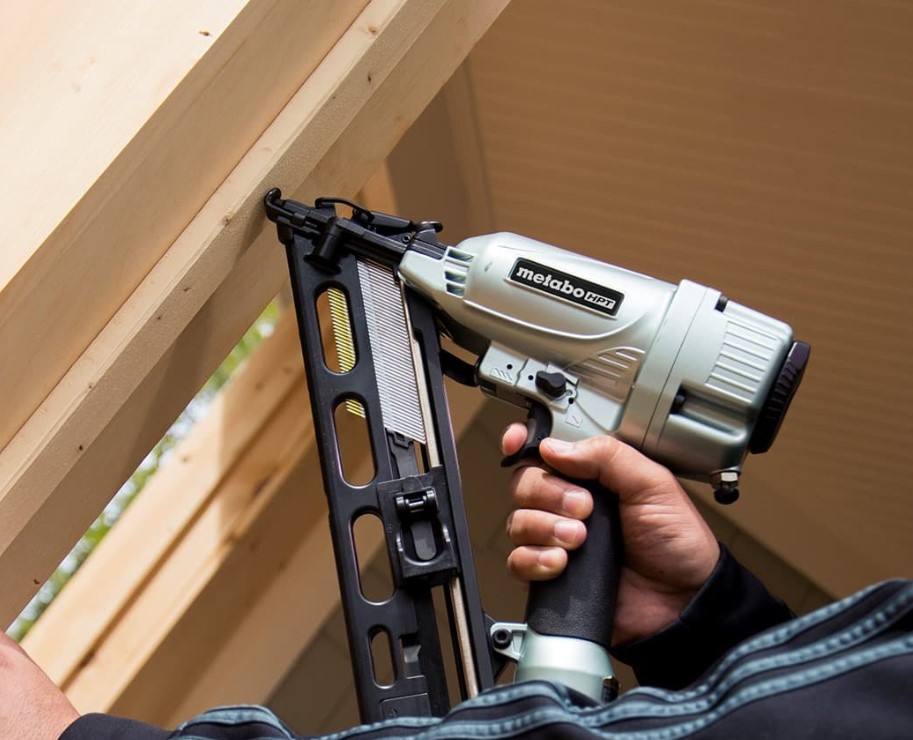
The finish nailers are used for polished and finished work. These nailers use small head nails for high accuracy and are often used for tasks like finishing cabins, trimming, working with a variety of woods, etc.
Dewalt Nailer DCN660B is considered to be the top-rated finish nailer.
Comparing Finish Nailers
| Finish Nailer Type | Best Category Product | Grade |
| Pneumatic | NEU MASTER 2 in 1 Nail Gun Staple | Average |
| Cordless | DEWALT (DCN650D1) | Better |
Here is what you need to know about the sub-categories of the finish nailers:
Pneumatic Finish Nailers
A Pneumatic Finish Nailer gun is used to attach finishing materials to a variety of surfaces, including wood, drywall, and plaster. It is often used for finishing work on interior surfaces, such as baseboards, crown molding, and trim.
Senco 4G0001N FinishPro is worth mentioning in this category.
They are the right choice if you’re dealing with DIY projects or if you’re a professional in this field.
Cordless Finish Nailers
These nailers have been made for high precision in driving nails for different tasks like construction jobs and trimming jobs etc.
Craftsman V20 Cordless is considered to be the overall best choice in the category.
These nailers are portable and flexible, which provides them mobility and convenience for the user.
The Pros
- These nailers are preferred at jobs where strength is a key factor because these nailers can use to attach materials together with high strength.
- These nailers are also quite easy to conceal with different types of fillers which creates a professional look.
- These nailers are applicable to furniture construction, cabinetry work, working with different types of wood, etc.
The Cons
- Finish nailers don’t have a depth adjustment feature which is a really big con.
- These nailers are quite heavy and are quite difficult to carry from place to place.
- The finish nails have a large size which might cause damage to the surface as it creates holes of large size as compared to other nailers.
Brad Nailers
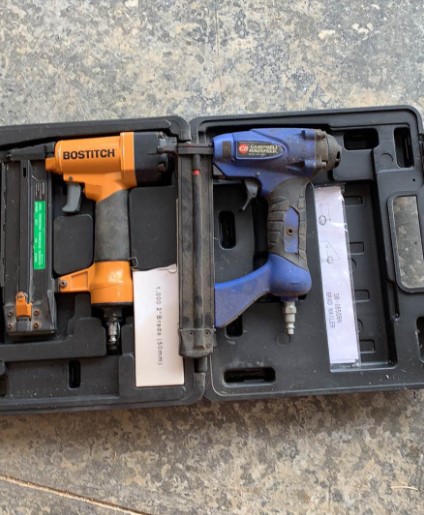
These nailers have work similar to that of finish nailers but they use nails of comparatively smaller size. These types of nailers are the best option for light-duty applications.
Bostitch BTFP12233 is considered to be the overall right choice for the Brad nailer category.
Comparing Brad Nailers
| Brad Nailer Type | Best Category Product | Grade |
| Cordless | KIMO 18 Gauge Nail Gun | Average |
| Pneumatic | WEN 61721 | Average |
Brad nailers also have sub-categories:
Cordless Brad Nailers
These nailers use rechargeable lithium ions battery for their operation which need to be recharged after the task is complete.
KIMO Nail Gun is considered to be a really reliable and overall good option in the cordless Brad nailer category.
Pneumatic Brad Nailers
Pneumatic brad nailers are comparatively cheaper, affordable, and easy to handle. But the limitations are that they can’t reach tight spaces and inaccessible places, unlike cordless brad nailers.
Worth mentioning in this category is the Ridgid R213BNF Brad which is a rather reliable choice in this category.
These brad nailers provide a comfortable grip some variants provide an ergonomic grip, have a large magazine for storing nails and they use thinner and small gauge brad nails which provide high and accurate results while dealing with tasks like trim work and other woodwork, etc.
The Pros
- These types of nailers involve small size nails and don’t damage the surface.
- The precision factor is quite high in this category.
- As these nailers are lightweight and portable, they can be easily carried from place to place without being hectic.
The Cons
- Brad Nailers can only be used for such tasks which involve small-sized brad nails for its working.
- The depth of the brad nails is also limited.
- It has limited strength as well because the nails used are of small size and are weaker as compared to other nails.
Pin Nailers
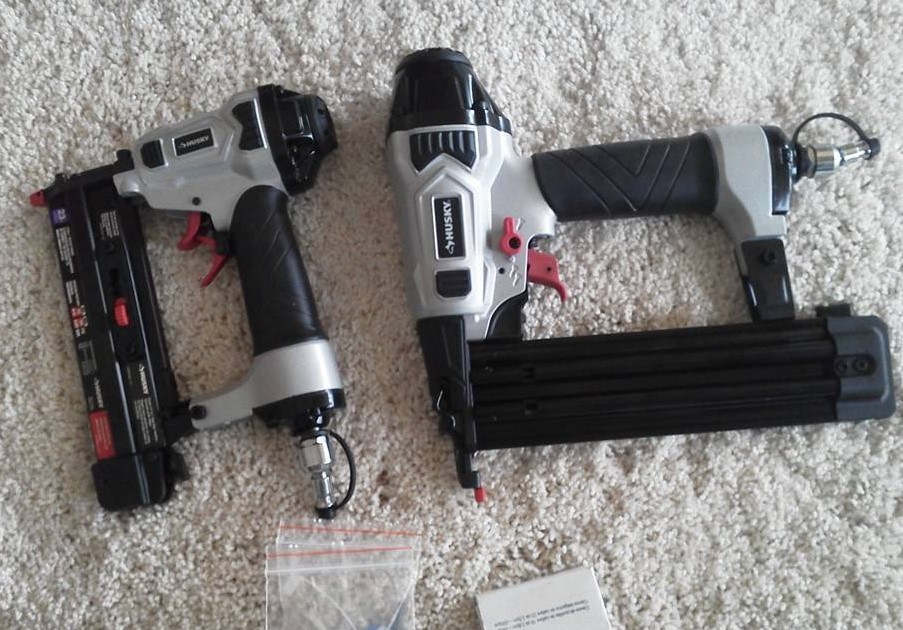
The next category is the pin nailers. These nailers are frequently used in woodworking or for other wood-related jobs like carpentry and for attaching small pieces of trim known as crown molding. It can also be used to attach baseboards and different types of frames to different surfaces. This nailer uses pins as nails.
Metabo HPT Micro Pin Nailer is remarkable in this category.
Comparing Pin Nailers
| Pin Nailer Type | Best Category Product | Grade |
| Electric | Ryobi 18-Volt | Average |
| Pneumatic | Arrow PT23G | Average |
I’ll discuss the sub-categories of pin nailers here:
Electric Pin Nailers
Bostitch HP118K is worth mentioning in this category.
Electric Pin Nailers use a motor-driven mechanism.
Pneumatic Pin Nailers
Pneumatic pin nailer guns are generally more powerful than electric pin nailers and can drive nails into harder materials.
However, they can also be louder and require more maintenance, since they have more moving parts than electric pin nailers. Additionally, the user must have access to an air compressor in order to use a pneumatic pin nailer gun.
Bostitch Pin Nailer 23 Gauge is worth mentioning in this category because it’s considered a really reliable option in the current times for driving nails by air power.
The Pros
- Pin nailers involve small pins which can be driven easily.
- These types of nailers are quite easy to use because they are quite lightweight and can be easily maneuvered without any kind of problem.
- The surfaces which are dealt with pin nailers are least affected and they stay polished even after the usage.
- These nailers are used in installing fabrics, trimming, etc.
The Cons
- Pin Nailers have limited strength.
- They have a limited depth limitation.
- These nailers are expensive and are quite fragile as well while handling.
Unique Nailers
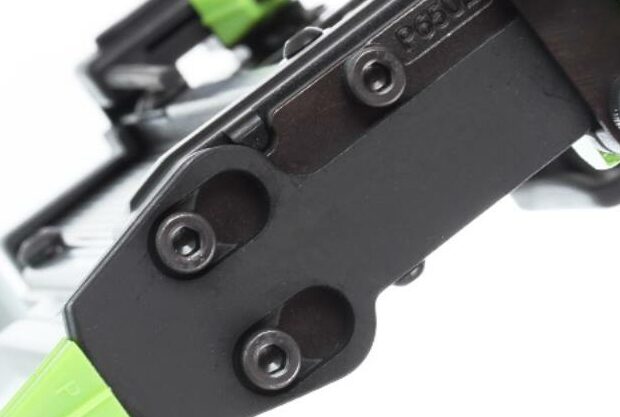
Unique Nailers, like Headless Pinners and Palm Nail Guns, are specialized nailer guns that are designed for specific tasks in construction and woodworking.
Comparing Unique Nailers
| Unique Nailer Type | Best Category Product | Grade |
| Headless pinners | Senco Headless Pinner 23 | Average |
| Palm nail gun | Metabo HPT NH90AB | Good |
Here are a few mentions:
Headless Pinners
The first category is the headless pinners. These nailers are also known as micro pinners. The round shape at the end of a Pin Nailer gun is actually the magazine. In the case of a headless pinner, which is a type of pin nailer, the magazine is designed to hold small, headless nails that are ideal for attaching delicate trim or decorative pieces without causing damage or leaving large visible holes.
The round shape of the magazine allows for the smooth feeding of the pin nails into the gun, which is essential for the efficient operation of the nailer. Without the magazine, the nailer would not be able to properly feed the pin nails into the gun, and it would not function as intended.
Senco Headless Pinner is worth mentioning in this category because of its demand.
Palm Nail Gun
These nailers are known as palm nail guns because they have small sizes and are handheld tools. These nailers can reach inaccessible, tight space areas which makes them portable and they are widely applicable to a variety of jobs.
Freeman 2nd Gen Mini Palm Nailer is considered to be an overall good palm nail gun.
The Pros
- These nailers are quite efficient.
- As these nailers use small size of headless pins, they avoid the splitting up of pins unlike large-sized pins and these pins can be used in different types of materials easily and with high power.
The Cons
- The cons of the unique nailers are that as these unique nailers involve the small size of pins, this limits their range of applications i.e.
- These nailers may also produce noise.
- These types of nailers are not that much powerful as compared to other nailers.
Staple Gun
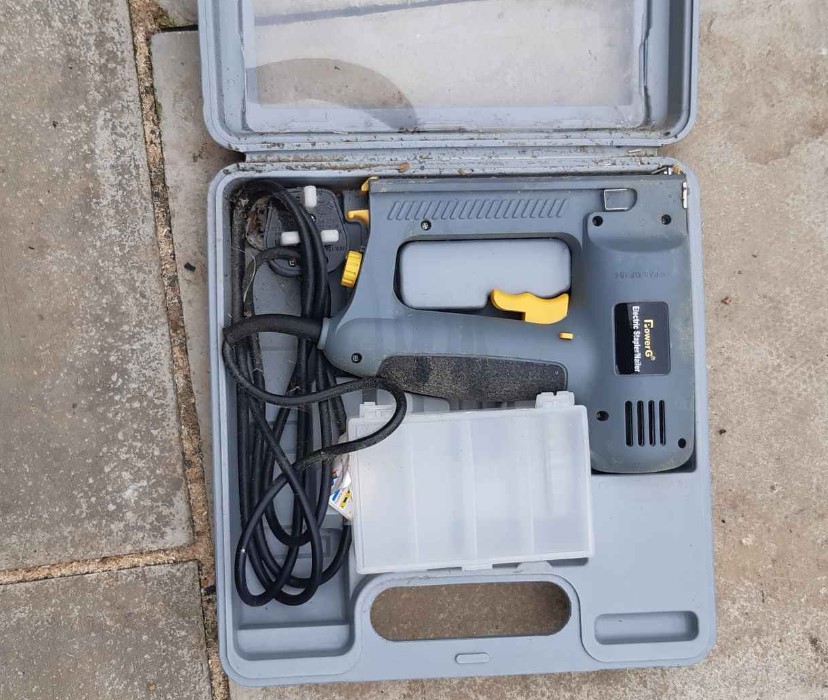
The last category is the staple bun. These types of nailers are also known as staplers and tackers. These nailers are often used for household jobs and daily life tasks, etc. The sizes of the staples vary from model to model.
Dewalt DWHTTR350 is considered to be a top stapler in the current times.
Comparing Staple Nailers
| Staple Type | Best Category Product | Grade |
| Pneumatic | Metabo HPT N3804AB3 | Excellent |
| Electric | WORKPRO 3.6V Electric Cordless | Good |
| Manual | YEAHOME 4-in-1 | Better |
| Hammer | Arrow HT50 | Better |
I’ll discuss the sub-categories of the staple gun below:
Electric Staple Gun
Electric Staplers are often used by carpenters, housewives, household people, etc. for doing jobs like installing carpets or fabric, installing insulations, upholstery, repairing furniture, etc. And electric staplers can easily help in getting the job done in no time.
Worth mentioning in this category is the Metabo N3804AB3. It has some restrictions i.e., due to being electric-powered.
Pneumatic Staple Gun
These types of staplers work quite well compared to that of electric staplers. These staplers are expensive.
Arrow PT50 is worth mentioning in this category because of its high rating performance and versatile nature.
Pneumatic staple guns need an ideal air pressure to work on in order to produce accurate and precise results. If the pressure is not adjusted according to the task, this may cause damage to the stapler as well as to the material being dealt with.
Manual Staple Gun
These staplers don’t require any kind of source as their power. They are ready to be used as soon as the user is ready. Manual Staplers are less expensive as compared to others.
YEAHOME is currently the most preferable manual stapler because of its quality, performance, and wide variety of materials this stapler can be used.
These are suitable for jobs like small constructions, DIY Projects, upholstery, etc.
Hammer Staple Gun
The last sub-category is the hammer staple gun. The hammer staple gun is also similar to that of the manual staple gun but there is a difference in the working of this hammer stapler. After filling its magazine with the staples of your choice. You need to use this stapler in the motion of a hammer as the name suggests as well to ensure complete stapling action.
Arrow HT50 (Check on Amazon) is a really preferable hammer staple gun if you’re looking for simplicity.
The Pros
- They are best for DIY work; these staple guns are not heavy-duty but they will get the job done.
- The stapling action is quite stronger than other fastening methods such as glue or tape etc. and it’s quite efficient as well.
The Cons
- If a person doesn’t know how to operate the staple gun correctly it will face many issues related to jamming. And staples will keep jamming from time to time which will ruin the surface as well your task.
- The use of staple guns can also cause injuries. If a person doesn’t know how to operate a stapler correctly, a misfire of a staple may result in injuries if proper equipment is not used as well.
FAQs
A lot of questions arise for different types of nailers. I’ve mentioned some FAQs right below and their appropriate answers as well for your help so that if you have any queries:
If you choose stick nails then they are better suitable for light and small jobs, while on the other hand coil nails are better suited for larger projects.
According to my research, an ideal PSI ranges from 70-90 PSI for the best performance and accurate results.
No, only pin nails can be used in pin nailers and brads can be used in the brad nailers respectively.
Mostly, manual or hammer staple guns are the cheapest nail gun if you’re dealing with lightwood work.
Recap
In this part of the article, I’ll give you a recap of the entire article and everything we have learned about the 9 different types of nailers.
Roofing Nailers: These nailers are used for installing different components on your roof as the name suggests. These are only limited to dealing with roofs and these nailers work with coil roofing nails which are suitable for the materials you are dealing with while roofing.
Flooring Nailers: You can use flooring nailers to drive specialized flooring nails into the floor for installing hardwood flooring or other types of flooring. It has worked similarly to that of other nailers.
Framing Nailers: You can use this type of nailer for dealing with different types of frames i.e., wood frames, for dealing with cabinetry work, or for different trimming jobs. These nailers use specifically framing nails for getting the job done.
Siding Nailers: These types of nailers involve siding materials together. They use wire or plastic-coated nails typically. The siding materials include vinyl, wood, fabric, etc. which can be easily attached to walls of the exterior of different types of buildings.
Finish Nailers: These types of nailers are used for giving that polished look to the surface you are dealing with. They use 15–16-gauge nails for finishing different tasks like trimming, cabinetry, different woodwork, etc.
Brad Nailers: These nailers use brads of various sizes. They don’t damage the surface of the material that is being dealt and these nailers are quite easy to use and maneuver.
Pin Nail Gun: These nailers are used to drive pin nails into different types of surfaces. As the pins are really small, they don’t have much depth but they can be easily driven into multiple surfaces easily without using much power and it produces efficient results at the end. They make really small holes and don’t cause much damage.
Unique Nailers: These nailers include headless nailers and palm nail guns. These nailers are really small in size, portable, and easy to handle as well as carry from place to place. Both of them use nails of really small size and these nails can be easily fired into the material of your choice. These staplers are expensive as well as versatile.
Staple Gun: These types of nailers use staples of various sizes to attach them together or for repairing purposes. The staplers vary according to the type of materials. These nailers are often used for light-duty jobs and it has multiple types including pneumatic, manual, etc. These nailers are quite cheap and easy to use compared to other types of nailers.
Bottom Line: What Type of Nailer Is the Best for You?
Now, as you have learned about 9 different types of nailers, the question arises what type is the best for you?
Before you go, here are a few things you need to consider:
- Power Types: Nail guns have two firing modes: bounce-fire, where nails are fired when the gun touches the work surface, and sequential firing, where the trigger must be pulled for each nail.
- Jam Clearing: To clear a nail gun jam, first disconnect the gun from its power source, then use the manufacturer’s instructions to safely clear the jam.
- Motor Types: The best way to narrow down the options is that there are two ideal motor types of nail gun – pneumatic, which uses air, and cordless, which uses small gas explosions. Pneumatic nail guns require an air compressor while cordless nail guns are more mobile and use disposable gas cartridges.
- Dry-fire lockout: Dry-fire lockout is a safety feature in nail guns that prevents the tool from firing when there are no nails left in the magazine. This helps prevent damage to the nail gun and ensures that you know when to reload nails.
- Nail Gauge Options: Nail guns come in different nail gauge sizes, which refer to the thickness of the nail. Common options include 15-gauge, 16-gauge, 18-gauge, and 23-gauge, with 16-gauge being the most versatile for various projects. Thicker gauges are used for detailed work and thinner gauges for installing trim.
- Nail Gun Angles: Nail gun angle refers to the way nails are collected and stored in the magazine, not the angle at which they are driven into the surface. Angles range from 15 to 34 degrees and determine the nail head type and magazine capacity. 15-degree nail guns are for framing, 21-degree for tight corners, 28-degree for compactness, and 30 degrees for corners and dual-strips magazines.
- Operating Pressure (PSI): PSI (pounds per square inch) is the unit of measurement for the air pressure used to power a nail gun. Look for the recommended operating pressure for your nail gun, usually between 70 and 120 PSI.
- Weight Matters: Consider the size and material of the nails you will be using, as heavier gauge nails will require a more powerful and heavier nail gun.
- Air Delivery (CFM): Airflow in nail guns is measured in CFM and varies depending on the type of nail gun. Knowing the required CFM will help you choose the right air compressor.
- Price: Price is a really important factor when it comes to buying a nailer. Are you looking for a cheap and affordable nailer? Do you want your nailer to be less expensive and cheaper?
- Nail Gun Trigger Mechanisms: Bump-Fire, One-for-One Trigger, Squeeze, and Release: These features are quite convenient for nailers. Are these features present in the nailer or not? Does the nailer offer these features?
- Nail Gun Sizes: Size is also very important in selecting the nailer of your choice. What size of nailer do you want for the job? Do you want it to be handheld or heavy-duty?
- Depth Adjustment of Nails: Depth Adjustment of nails is also very essential according to the user’s requirement. Does this nailer provide depth adjustment? Until which depth adjustment do you want your nailer to go?
- Nail Gun Triggers: Here are the standard types of triggers;
One-for-One: One pull of the trigger equals one nail, which is common on staple or brad nailers.
Bump-Fire: You press the trigger and bump the nail gun where you’d like to drive the nail.
Squeeze & Release Mechanism: Common on expert models, these triggers are sensitive and have a tendency to drive multiple nails. They usually have multiple settings, so look for a nail gun with a trigger that’s large and easy to press while wearing gloves.
